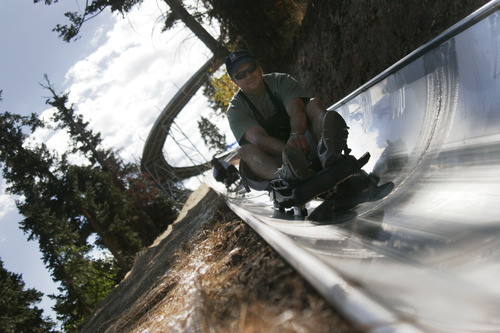This is an archived article that was published on sltrib.com in 2011, and information in the article may be outdated. It is provided only for personal research purposes and may not be reprinted.
One of many dreams battered by the 2008 financial collapse was the Utah Athletic Foundation's hope of running Utah Olympic Park and the Olympic Oval without having to make raids on the $76 million endowment left by the 2002 Winter Games.
But the cost of operating those two facilities as they were intended to be used is too expensive to be covered completely by user fees, so the foundation has been forced to dip into the endowment. At the rate it is being nibbled away, the fund will be depleted in 2030, Foundation President/CEO Colin Hilton said Tuesday in a luncheon address to the Salt Lake City Rotary Club.
The easiest way to extend that deadline would be to strictly curtail many programs established over the past nine years to get people (especially youth) involved in all sorts of winter sports, be it skating, sliding, skiing, jumping or doing aerial maneuvers.
But Hilton is not about to do that. He plans to keep running programs until the endowment runs out.
"If our only goal is to keep the doors open, what's the point?," he asked rhetorically. "We're engaging kids in programs and that's the right thing to do."
Hilton could forestall the demise if he succeeds in finding other ways to supplement foundation revenue, perhaps from wise use of the undeveloped lands between the Olympic Park's exit off State Road 224 near Kimball Junction and the base of its ski jumps.
Athlete housing, sports medicine clinics and offices for teams whose elite athletes train at the facilities are possibilities, he said. "The best thing we have going for us is location, and we'll take advantage of that in a smart way."
But it still will be a challenge to make ends meet, Hilton acknowledged. Operations at the speedskating oval alone require a $1.5 million subsidy each year, even with participation in learn-to-skate programs increasing from 850 in 2009 to 1,130 last year, the third straight annual increase.
The endowment, which started out at a remarkably large $76 million because of efficiencies in the Salt Lake Organizing Committee's operation, is down to about $65 million after peaking in the low $80 million before the downturn. The smaller it gets each year, the less interest revenue is generated, so more principal has to be withdrawn to cover costs, which leads to even less revenue the next time around.
So what if Salt Lake City goes after the Olympics again? If organizers made money the first time in putting on a highly successful Games, why couldn't they do it once more, using sponsorship money to reinvigorate the facilities and build even more public interest in winter sports?
Hilton said that's the question he dreads — but still gets — every time he speaks about the Olympic legacy facilities. He's reluctant to answer it because he knows how much politics surround the host-city selection process, intrigue way beyond his world of striving to make Utah's facilities viable.
But Hilton said he knows Salt Lake City could do it again. The community showed its ability in 2002 and it has done so since then, not allowing any of its facilities to become "white elephants," using them instead to instill a legacy of sports in tens of thousands of participants.
"To me," he said, "it's just a matter of time."
Hearty thanks
Salt Lake Rotarians gave a warm round of applause Tuesday to member Frank Joklik for his involvement in the 2002 Winter Games, as chairman of the city's bid committee and, later, as the second of three presidents of the Olympic organizing committee.







